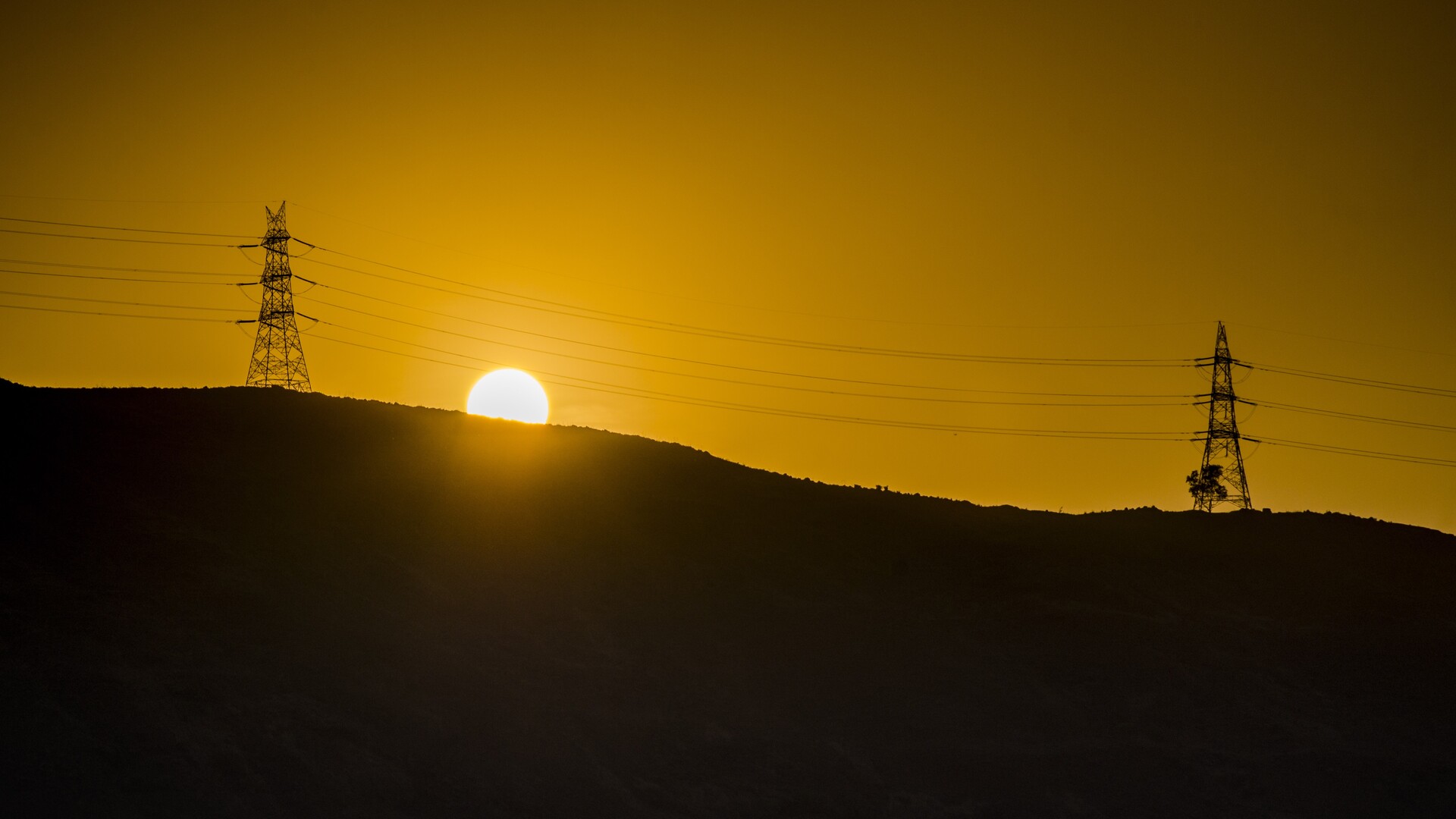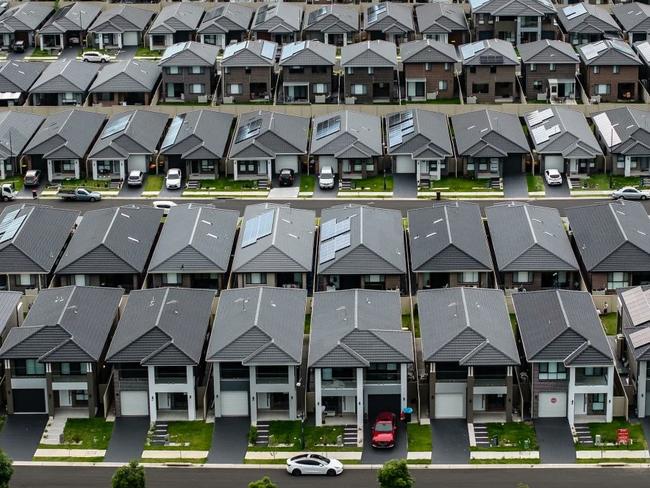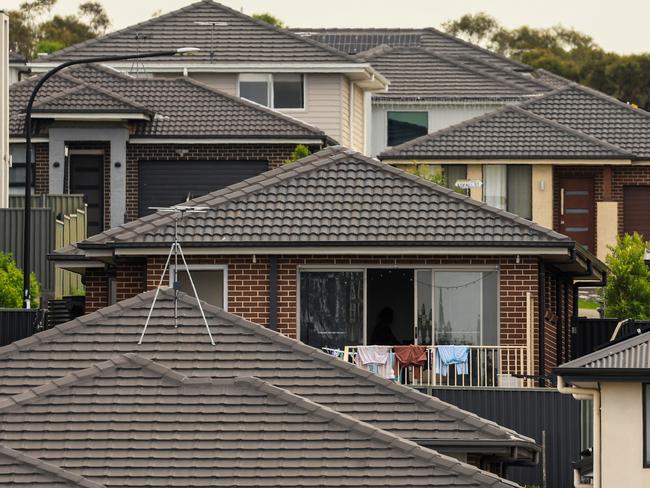Heatwave sparks renewed calls for ‘outright ban’ on black roofs
Scorching temperatures across much of Australia this week have reignited calls for an “outright ban” on a popular home feature.

Sustainability
Don't miss out on the headlines from Sustainability. Followed categories will be added to My News.
Scorching temperatures across much of Australia this month have reignited calls for an “outright ban” on black and dark-coloured roofs.
Seas of black and dark grey roofs are an extremely common sight in new developments ringing capital cities like Sydney and Melbourne, but there have been growing calls in recent years to crack down on the popular trend which has taken hold over the past two decades.
“Just about every roof in western Sydney is black,” city planner Samuel Austin said told news.com.au earlier this year.
“Fifteen or so years back, having a dark-coloured roof became really popular. They look stylish and modern, so people loved them. The problem is, that’s a 150 square metre surface sitting in the sun all day attracting and absorbing huge amounts of heat.”
Experts have long warned that the urban heat island effect, in which certain pockets experience significantly higher temperatures than surrounding areas and cool more slowly at night, will only worsen as the climate warms.

The mercury in parts of Sydney and Melbourne topped 40C last week, sparking heatwave warnings and power outages affecting thousands of homes.
The Bureau of Meteorology and the CSIRO have warned that Australia faces increased hotter temperatures and decreased rainfall in coming decades.
The latest biannual State of the Climate report, published in October, found that Australia’s climate warned by an average of 1.51C since records began in 1910.
“Australia’s warmest year on record was 2019, and eight of the nine warmest years on record have occurred since 2013,” the report stated.
“In the record warm year of 2019 there were 40 days with extremely high nationally-averaged mean temperatures (those in the warmest 1 per cent of days for each month), about three times more extreme heat days than any year prior to 2000. Also in 2019, there were 33 days when national daily average maximum temperatures exceeded 39C, a larger number than seen in the 59 years from 1960 to 2018 combined.”
Janine Strachan, chief executive of the Insulation Council of Australia and New Zealand (ICANZ), said the report should be a wake-up call for state and federal governments, planning authorities and industry, which have dragged their feet on reforms to thermal efficiency standards in the face of financial woes affecting the building sector.
“We need to recognise that the houses of the future we need to be building now are more resilient in the changing climate,” she said.
Ms Strachan backed an “outright ban” on dark roofs in particular, which should be “seen as a no-go point moving forward if states really want to take their urban development seriously”, particularly in hotter parts of the southeast.

In January, South Australia became the first state to take action, announcing that dark roofs would be eliminated from all future stages of Playford Alive, a mammoth 500-hectare housing development in Adelaide’s northern suburbs.
A report by Seed Consulting, which heat-mapped Adelaide’s northern suburbs, found homes with light-coloured roofs were 4.3C cooler on an average day than dark roofed homes.
Urban planning expert Professor Sebastian Pfautsch from the Western Sydney University has led calls for state governments to ban dark roofs.
“The decision to ban dark roofs outright must be replicated in Victoria and New South Wales where developers and consumers continue opting for materials that amplify urban heat,” Prof Pfautsch said earlier this year.
“In a warming area this development puts lives at risk. During a heatwave, when all these dark- roofed suburbs will run their airconditioning systems, the high demand increases the risk of blackouts. And when the airconditioning goes occupants will be severely impacted by heat.”
Prof Pfautsch said appropriate selection of materials and colours combined with high-quality insulation were the “low-hanging fruit of climate-responsive urban design”.
“Government, industry and homeowners all play a role in making our neighbourhoods cooler,” he said.
Under the 2022 National Construction Code (NCC), all new Australian houses and apartments must meet a minimum energy efficiency rating of seven stars under the Nationwide House Energy Rating Scheme (NatHERS).

But facing pressure from the construction lobby, South Australia and Tasmania recently declared a freeze on changes to the NCC for 10 years, rather than the regular three-year updates.
Opposition leader Peter Dutton followed suit in October, announcing the Coalition would also commit to a 10-year freeze on national building codes.
The Coalition said Labor’s changes to the NCC had “added red tape and increased the compliance burden for new housing projects, driving up costs for purchasers”.
It claimed that lifting the minimum energy efficiency standards from six to seven NatHERS stars would add $60,000 to the cost of a new home — a figure disputed by industry groups.
The Australian Glass and Window Association estimated the cost was $5000, while the Australian Building Codes Board said it was closer to $2200 in 2021 terms.
“Our concern is that they’re providing regulations for new housing that is not going to keep up or be resilient in the face of a changing climate, as well as dismantling and threatening the uniformity of a national construction code,” Ms Strachan said.
She added that another problem was the NatHERS system using outdated climate data, leading to perverse ratings outcomes.
“Until two years ago NatHERS was using old climate data up until 1990, which wasn’t reflective of the current situation and also the future project climate,” she said.
“Therefore climate zones such as Victoria, the ACT and Tasmania in particular were getting an uptick on their energy rating report if they used a dark-coloured roof, it could have been up to half a star … so there was that motivation.”
Ms Strachan said the result was “locking people into future housing stock based on data that’s not really current”.
“These homes will be there for 50 years, they will be there and they will be occupied as we move into this changing climate,” she said.
— with Shannon Molloy
Originally published as Heatwave sparks renewed calls for ‘outright ban’ on black roofs





